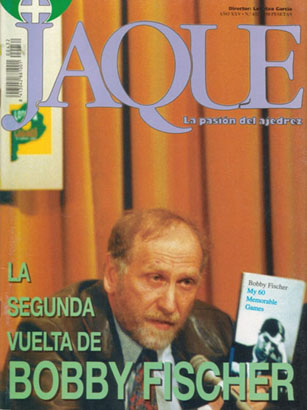
Edward Winter
(1999, with additions)
‘It’s a great book without a doubt, and can go straight on the shelf alongside Alekhine and Tarrasch and fear no comparisons.’ That was the opinion of W.H. Cozens in a review (December 1969 BCM, pages 370-371) of Bobby Fischer’s My 60 Memorable Games, published by Simon & Schuster in the United States and by Faber and Faber in the United Kingdom. The book continued to receive the highest plaudits from chess enthusiasts of all levels throughout the world, but then came disaster; in 1995 B.T. Batsford Ltd. produced an algebraic edition.
At first, nothing seemed amiss. Page 188 of the April 1995 BCM, for example, gave a hearty, if brief, welcome to ‘this great classic’ and concluded ‘The best chess book ever written?’ Everybody was glad that new generations of players unreceptive to the descriptive notation could enjoy Fischer’s work, and nobody realized what Batsford had done to it.
Nobody, that is, until June 1996, when Fischer gave a searing press conference in Buenos Aires. He denounced the Batsford edition as forged and unauthorized and accused the company of having intentionally included many changes to it, in an attempt to make him look foolish. His salvos were reported in detail on pages 6-12 of issue 432 of the Spanish magazine Jaque (September 1996), whose front cover sported a photograph of Fischer holding up a copy of the offending book.

The magazine also reprinted a conversation some ten days later between Fischer and Juan S. Morgado in a Buenos Aires bookshop. Fischer declared that the Batsford team were ‘criminals’ and ‘conspirators’ and added: ‘They changed everything in my book, the notation, the format, the pages, the analysis … and without paying royalties.’ [As related below, in an addition dated 10 November 2012, Fischer had conversations in the bookshop with both Juan Sebastián Morgado and Pedro Federico Hegoburu, but it was to the latter that Fischer addressed the complaints about the Batsford book cited here.]
Batsford swiftly issued a statement, professing itself ‘appalled’ by Fischer’s remarks. It said that it had purchased the right to publish the book from Faber and Faber, and that this ‘included the power to make alterations to make the book suitable for the British market’. It was thus converted to the algebraic notation and, Batsford added, ‘our intention was to produce an edition that was accurate and faithful to the original. There was no addition or subtraction of intellectual material’.
John Nunn, the book’s typesetter, adopted a similar line of argument in an e-mail message to Larry Evans. It was quoted by the latter on page 8 of Inside Chess, 23 December 1996:
‘So far as I can see there have been no changes to the intellectual content of the book, either by subtraction or addition. Only one piece of analysis was changed, because a mate in four had been overlooked in the original book. Quite honestly, I can’t see any grounds at all for complaint.’
Batsford said in its statement that it had written to Fischer enquiring where royalty payments should be sent and asking whether he wished to be involved in the new edition. ‘The only reply took the form of a letter from Bobby Fischer’s lawyers, querying our right to publish the book. We can only presume that the response satisfied them, since they have not come back to us in the year and a half since then.’ Batsford concluded: ‘Thus we really don’t see any grounds for complaint, and continue to wait for Bobby Fischer to provide an address to which royalties should be sent.’
It would be pointless to speculate on these contractual details or letters, but the affirmation that the book’s content was not changed can be called, loud and clear, a falsehood. Fischer’s book had not only been changed, it had been butchered – deliberately, wantonly and more or less systematically.
First, the case mentioned by Nunn to Evans, where the Batsford edition sought to correct some analysis in which Fischer had allegedly missed a mate in four. In fact, it was Batsford’s own blunder:

In this position, arising from a note at Black’s 35th move in Fischer v Bolbochán, Stockholm, 1962 (game 35), Fischer wrote that 40 Qxf1 leads to a win, but Batsford changed this to ‘40 Qh7+ Kf8 41 Qh8+ Qg8 42 Qh6+ Qg7 43 Qxg7 mate’. The only problem, of course, is that 42 Qh6+ is illegal, because 41…Qg8 has given check.

From page 135 of the Batsford edition
The November 1996 CHESS (pages 26-29) set out Fischer’s grievances (including the Bolbochán episode), whilst leaving in abeyance the question of how many changes Batsford had made. The January 1997 issue devoted nine pages to the controversy. First, there was a one-page account by John Nunn. He stated that he had been the book’s typesetter, not its editor, and objected to the claims by CHESS along the lines of ‘Nunn has added …’. He commented, ‘After such a time, it is impossible even for those who worked on the book to say exactly who changed what’. Nunn also said that there was only one change to Fischer’s analysis (i.e. in the Bolbochán game, now acknowledged not to be Fischer’s error after all). Next, Nunn disputed the claim by CHESS that Fischer had taken great care over his book. ‘If he was so careful, then it is hard to explain why there were over 200 notational errors and ambiguities in the original edition of Fischer’s book. In game 52, for example, there were seven such … It seems a poor reward to correct 200 errors and ambiguities but overlook one, and then be attacked for my involvement in the book.’
Most of Nunn’s other comments were in reply to CHESS’s criticism of the new book’s typesetting and presentation (i.e. double columns, the use of italics, etc.). These issues are not of direct relevance here, although they offer another example of the unfortunate desire to force Fischer’s masterpiece into the Batsford sausage machine.
Next up at the stand was Graham Burgess, then the ‘Managing Editor’ of Batsford’s chess list. He too stressed Batsford’s correction of ‘literally hundreds of errors and ambiguities in the original notation’ but added ‘nevertheless, it is indeed highly unfortunate that we introduced one error, the mate-in-four-which-isn’t in the notes to Fischer-Bolbochan, Stockholm 1962. This was the only change to the chess content of the book.’
Burgess gave a gaffe-by-gaffe account of how misunderstandings between Nunn and him had resulted in the illegal mate being published, and on the general question of textual changes he declared:
‘It is worth mentioning that it is standard in the typesetting process to make minor adjustments in the wording to improve the appearance of the text on the page in terms of spacing, line breaks, column breaks and page breaks.’
The reply by CHESS in the same issue addressed the above points head-on. The magazine admitted that when Fischer’s book had been issued the previous year it had given it merely ‘a quick glance’, on the assumption that ‘John Nunn, custodian of chess quality, had at least produced an accurate version of the 1969 original’. Concerning Nunn’s point that the original descriptive edition had many typographical errors (particularly in the moves), CHESS quoted Fischer’s acknowledgement that there had been ‘millions’ of typos, as well as his comment, ‘I don’t need them [i.e. Batsford] to correct anything for me, even with the help of computers. Of course the book has mistakes, but I can correct them myself. They changed my things on purpose …’ CHESS added that Fischer had taken great care with the book’s analysis.
The magazine then discussed the various statements by Nunn and Burgess as to who had done, or not done, what. For the record, it may simply be observed here that the copyright page of the Batsford book lists five people: a three-man ‘Editorial Panel’ (Mark Dvoretsky, John Nunn and Jon Speelman), a ‘General Adviser’ (Raymond Keene) and a ‘Managing Editor’ (Graham Burgess). In addition, Nunn is referred to as the book’s typesetter. He receives a further mention on the back cover: ‘Reset by John Nunn into modern algebraic notation, with many extra diagrams.’
As regards that typesetting, or resetting, CHESS noted that ‘Nunn had before him the task of neatly accommodating 384 generously laid out single column pages of the original book into 240 packed double column pages for the Batsford edition and ran into all sorts of problems. Rewording in order to shorten or lengthen text became the norm, diagrams frequently had to be placed out of sequence from related moves and text, losing impact, and, worst of all, in a few desperate cases, whole lines of text were actually eliminated. Sacrilege!’
Yet, as noted above, Burgess had claimed that nothing untoward or unusual had been done on the typesetting front. Jeremy Silman was later to comment acidly in his ‘Inside Chess Online’ review of My 60 Memorable Games:
‘Mr Burgess, I don’t know where you learned this “standard” typesetting law, but any major publishing house in the United States would instantly fire any typesetter doing this kind of thing. A typesetter who butchers an author’s work to make his own job easier should find a new vocation.
… Burgess seems to be saying that the typesetter is the one responsible for all the textual changes (and then he says that this is perfectly all right). Nunn says that he didn’t really make any errors, and that his only job was to typeset the book! Dr Nunn, are you responsible for all the textual changes? Is Burgess? Who is? Do you think that such changes are justified? Can you honestly say that you wouldn’t mind if I made hundreds of textual changes to one of your books someday?
Quite frankly, I am tired of Mr Burgess, Dr Nunn and Batsford pointing out the errors they corrected … while simultaneously excusing themselves for the mess they made of everything else. Why not take a mature stand and simply admit that bad judgment was used and, hopefully, that it won’t happen again? We are not dealing with a government conspiracy here, gentlemen. Isn’t it time to come clean and put this nonsense behind you?’
By that time, though, Batsford was disinclined to comment further, whether mendaciously or otherwise, and the shutters were put up. On many previous occasions the company had resorted to a similar policy of tactical silence, most notably on matters concerning the misconduct of Raymond Keene, where a hope-it-blows-over approach was the only chance.
Below are the front covers of various editions in our collection, as follows: the first printing of the original (1969) edition from Simon & Schuster, a subsequent paperback from the same company, two editions (still descriptive) from the British publisher Faber and Faber, and the 1995 Batsford version:

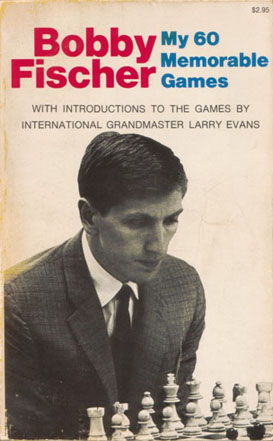
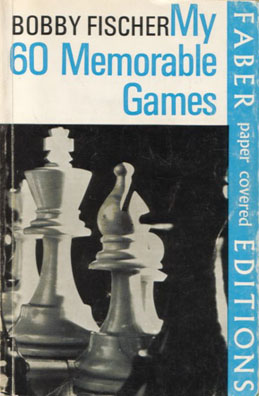


In the face of Fischer’s denunciation of Batsford and the latter’s refusal to admit wrong-doing, CHESS had engaged us to make an assessment of the extent of the textual changes made. It was apparent that a mere spot-check would not suffice, and we thus compared line-by-line the Faber and Faber edition and the new Batsford version. This verification work showed that over 570 changes had been made by Batsford, and a range of examples was presented on pages 45-48 of the January 1997 CHESS. We found that entire notes of Fischer’s had been omitted, individual words had been deleted, other words had been added and – the most frequent occurrence – Fischer’s wording had simply been changed without justification. Inconsistency had been introduced, a number of misspellings in the original had been left uncorrected, and many fresh mistakes had been added by Batsford.
In fact, the bad news started as early as the Contents page, Batsford’s carelessness being such that it reproduced the list of games from the original edition without changing the page numbers, which were thus all wrong. At the other end of the book, the headings for Fischer’s tournament and match results listings were incorrectly tabulated. In short, the care and attention accorded to Fischer’s magnum opus were no greater than what had been offered, over many years, to the seemingly endless stream of Batsford disposables which had inundated the chess book market.
With Fischer’s prose Batsford simply did whatever it wanted. Where Fischer had ‘Black’s better’, Batsford wrote ‘Black has secured an advantage’. Where Fischer said that a move was ‘murderous’, Batsford put ‘deadly’. Where Fischer used the term ‘accelerated Dragon’, Batsford preferred ‘the Hyper-Accelerated Dragon’. On page 48, Batsford altered the spelling of a player’s name – but wrongly, turning a Russian into a non-existent Yugoslav. After White’s 39th move in Game 60, Fischer wrote a 12-word note which Batsford just dropped. In Game 50, eight notes in a row contained modifications of the American’s writing. Another example of pointless chopping and changing is Game 52, and the note to Black’s 12th move in Fischer v Rossolimo, United States Championship, 1965-66. In the original edition Fischer wrote:
‘Better is the natural 12…Q-R4 (if 12…P-KN4; 13 Q-B6!, QxQ; 14 PxQ, P-N5; 15 N-K5, PxP; 16 PxP, NxP; 17 P-KR3 with a better ending); 13 QR-N1 (if 13 KR-N1, P-N3; 14 P-QR4, B-R3; 15 B-N5, QR-B1; 16 PxP, PxP; 17 BxN+, RxB; 18 R-N8+, R-B1 holds), P-N3; 14 PxP, QxBP; 15 N-Q4, NxN; 16 PxN, Q-R4+ with equality.’
Batsford took it upon itself to redraft the note as follows:
‘Instead, 12…g5 13 Qf6! Qxf6 14 exf6 g4 15 Ne5 cxd4 16 cxd4 Nxd4 17 h3 gives White a better ending, but the natural 12…Qa5 is better, e.g. 13 Rab1 (after 13 Rhb1 b6 14 a4 Ba6 15 Bb5 Rc8 16 dxc5 bxc5 17 Bxc6+ Rxc6 18 Rb8+ Rc8 Black holds) 13…b6 14 dxc5 Qxc5 15 Nd4 Nxd4 16 cxd4 Qa5+ with an equal position.’
Batsford was obviously making itself a laughing-stock. The Summer 1997 issue of Kingpin (page 68) carried a spoof Batsford advertisement featuring ‘My 60 Unforgettable Games’ (‘Fischer’s masterwork, totally rewritten but with no changes to the original text’). Also listed was the fictitious work ‘The Concise Batsford Book of Chess Quotations’, which included a Tarrasch observation: ‘Chess, in common with amorousness and musical compositions, has the ability to give contentment to people.’
It should not, however, be imagined that the revelations about Batsford’s behaviour provoked outrage in all quarters. In the letters section of the February 1997 CHESS, for example, Julian Hardinge of Glasgow was accorded about 70 lines to react to our verification of Fischer’s book. He spent most of his space attacking us personally, since he saw nothing wrong in what Batsford had done. ‘Examination reveals almost all of these differences to be entirely devoid of significance’, he wrote, without bothering to wonder why, in that case, Batsford had made the changes in the first place. Question: who is J. Hardinge? Answer: an associate of Raymond Keene, and the co-publisher of that appalling Keene/Divinsky book Warriors of the Mind. In fairness to CHESS, it should be added that in a subsequent issue it offered us an apology for having published such personal attacks.
Batsford found itself one other defender, though, again, it was hardly an impressive one. On page 41 of the January 1997 CHESS Graham Burgess wrote:
‘The comments of Larry Evans, in his Evans on Chess column from August 2, 1996, are worth quoting. Evans assisted Fischer in assembling the book, and wrote the introductions to the games. Having compared the two editions, he wrote of the Batsford book: “As Fischer’s collaborator on the original, I can attest that this edition is better!” Larry was also delighted to see some old typos corrected, e.g. 50…Kc7 instead of the faulty 50…B-R8 in Game 17.’
Indeed, on page 42 of the same issue of CHESS, Evans went further still, claiming that the above-mentioned change in Game 17 ‘goes a long way toward superseding all the other objections put together!’ Despite stiff opposition, that remark is perhaps the most foolish that Evans has ever made. Jeremy Silman later commented: ‘I was outraged when Larry Evans wrote that the correction of one obvious typo outweighed all the errors and changes.’ Even Hans Ree, who showed on page 95 of the 3/1999 New in Chess that he has yet to come to grips with the extent of the Evans problem, acknowledged that, at least in this case, ‘Larry Evans really played a silly role’.
It even turned out that, contrary to his earlier claim, Evans had not bothered to compare the descriptive and algebraic versions of Fischer’s book. His CHESS article had concluded, ‘The outrage over this edition seems like a tempest in a teapot’, and he used those last five words, followed by a question mark, as the title of an article published on page 8 of the 23 December 1996 issue of Inside Chess. There he claimed that Batsford had acquired the rights from Simon & Schuster (no, from Faber and Faber) and that the December 1996 CHESS had defended Fischer and found ‘some 600 changes’ (no, our article mentioned a total of around 570 and it was not published until the January 1997 issue). This caught Evans out. His own article had appeared before then, yet in it he gave the false impression that he had already seen the CHESS evidence regarding the extent to which Batsford had defiled the book.
In Inside Chess Evans concluded:
‘Yes, sloppy mistakes were made; yes, Bobby’s prose was disrespected; but I see nothing “malicious” in Nunn’s emendations, as Bobby claims. Since Batsford pledged to fix its next printing, the outrage over this one seems like a tempest in a teapot.’
On pages 3-4 of the 31 March 1997 Inside Chess we drew attention to an assortment of deficiencies in Evans’ position, but his replies showed him to be unrepentant and hopelessly out of his depth on what was, after all, an issue of principle, ethics and common sense. (Changing an author’s book without his permission is simply wrong.) Inside Chess decided to leave the matter there, on the grounds that our published exchanges with Evans had already ‘made him look a fool’. [Communication to us from Yasser Seirawan.]
As mentioned earlier, we counted over 570 textual changes, but in 1999 there was a curious twist to the story, with Fischer’s fury directed at us. In a radio interview on 10 March 1999 he called us a ‘bastard’ on the grounds that we had grossly underestimated the number of alterations made by Batsford; he asserted that there were ‘thousands upon thousands and thousands and thousands of changes’. In a subsequent radio interview (27 June 1999) he let fly again, even suggesting that we had given an artificially low total because we were ‘working for the Jews’. Since our figure was correct, in Chess Notes (items 2268 and 2298) we felt obliged to deal with Fischer’s substantive arguments, but in a sense this is a side issue. If Batsford had made a mere dozen textual changes to Fischer’s book, that would have been 12 too many.
Nor is there much point in spending time on Fischer’s dislike of our comment, adjudged far too weak, in the 31 March 1997 Inside Chess that he had been treated ‘scandalously’ by Batsford. Fischer argued in his radio interview on 27 June 1999 that it was far worse than that: it had been a criminal act. A similar view, as it happens, was expressed by Hans Ree on page 95 of the 3/1999 New in Chess:
‘In the Netherlands such changes constitute a criminal offense that could theoretically lead to a prison sentence. I hope the same goes for Britain. Anyway, Fischer had been quite right in his anger.’
The idea of anyone from Batsford being slammed into the cooler is implausible, whatever attractions it may hold for some. Messrs Nunn and Burgess left Batsford shortly after the exposé in CHESS, though they have remained in the chess book industry. An apology from them over the Fischer affair is still awaited. Evans, for his part, continues his deceptive attempts to play down what Batsford did, an additional instance being in the August 1999 Chess Life (page 13), where he merely says that the book was ‘not entirely faithful to the original’. (He also described it as ‘revised by John Nunn’.)
The corrected edition of My 60 Memorable Games ‘pledged’ by Batsford has never appeared, and it may be quite a wait for a proper algebraic edition, i.e. for Fischer’s own book without any arrogant attempts by others to improve it or fit it into a predetermined amount of space. It is hard to imagine that Fischer would ever become a Batsford author of his own free will, and the contractual situation for his book must be murkier than it was in the mid-1990s. But even if the rights to My 60 Memorable Games were on offer on the open market, where is the publishing house that Fischer could trust to bring out an algebraic edition with no changes other than those he himself wants to make?
Addendum concerning our 1999 remark ‘Messrs Nunn and Burgess left Batsford shortly after the exposé in CHESS, though they have remained in the chess book industry’: over subsequent years, John Nunn, Graham Burgess and Murray Chandler have built Gambit Publications into a publishing house with an exceptional range of high-quality chess books.
The above article was first published in 1999, at the Chess Café. Three years later we received the following from a British correspondent, Steve Giddins, and quoted it in C.N 2762:
‘Regarding the embarrassment over the note to Black’s 35th move in Fischer-Bolbochán, Stockholm, 1962, where Batsford changed Fischer’s analysis to reflect a forced mate which in fact did not exist, it has now come to my attention that the same error is made in the Russian book 744 partii Bobbi Fischera. Like many Russian books, this one reproduces annotations from other sources (presumably without paying royalties), including those from My 60 Memorable Games. The relevant note to Fischer-Bolbochán (volume 1, page 283) ends “39 Qh3+ s matom” (i.e. “with mate”), rather than “39 Qh3+ Kg8 40 Qxf1 leads to a win”, as Fischer originally wrote.
It thus appears that the Russian authors have not only fallen into the same tactical trap as Graham Burgess did in the Batsford book but that they have also, like him, changed Fischer’s own analysis, rather than merely adding a footnote pointing out the alleged “error”.
The Russian book came out in 1993, two years before the revised Batsford edition, so the latter was clearly not the source for the translation.’
In C.N. 2768 we commented:
‘The relevant part of the Fischer-Bolbochán game in the Russian translation of Fischer’s own work, Moi 60 pamyatnykh partii, was identical to what appeared in the book 744 partii Bobbi Fischera.
As regards the volume by Fischer, therefore, the Russian translation (1972) and the Batsford book (1995) both made the same silent ‘correction’ of his analysis, i.e. they both introduced, in Fischer’s name, a mating line which was nothing of the kind. A plain question arises: was this coincidental?’
C.N. 3871 (5 August 2005):
Zalmen Kornin (Curitiba, Brazil) points out to us that the same illegal line of play appeared in Schachmeisterpartien 1960-1965 by Rudolf Teschner, a book which was first published in 1966.

The imprint page of our copy has ‘© Philipp Reclam jun. Stuttgart 1966’ and ‘Printed in Germany 1972’, and below is the relevant extract, from pages 103-104:
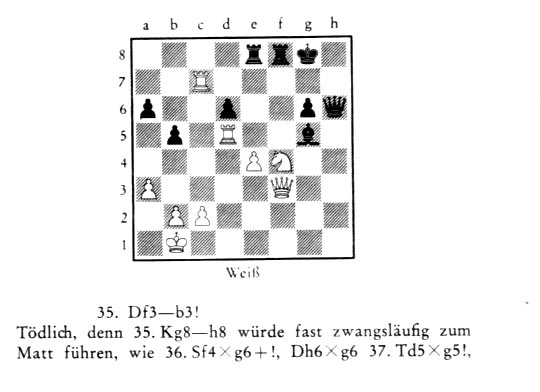
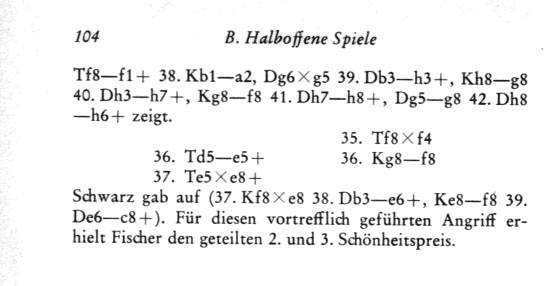
English translation of the note at move 35: ‘Deadly, since 35...Kh8 would almost inevitably lead to mate, as is shown by 36 Nxg6! Qxg6 37 Rxg5! Rf1+ 38 Ka2 Qxg5 39 Qh3+ Kg8 40 Qh7+ Kf8 41 Qh8+ Qg8 42 Qh6+.’
This is the identical mate-that-isn’t line which Batsford misattributed to Fischer in 1995. It will be appreciated if a reader who has the first (1966) issue of Teschner’s book could confirm that its text is identical to what has been reproduced above from the 1972 printing. If such is the case, it will have been found that this spurious mate had appeared in chess literature even before the publication (in 1969) of the first edition of My 60 Memorable Games. [It was subsequently possible to establish that the 1966 edition of Teschner’s book did indeed have the identical text.]
C.N. 3876 (6 August 2005):
Below is a photograph of Julio Bolbochán, from page 55 of the February 1956 issue of the Argentinian magazine Ajedrez Revista Mensual:
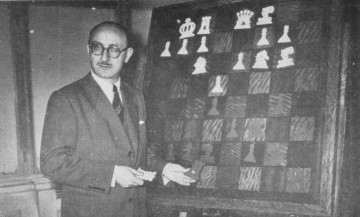
Peter Anderberg (Harmstorf, Germany) has now found that the
spurious mate under discussion appeared in print shortly after the
Fischer v Bolbochán game was played. Our correspondent quotes
Ludwig Rellstab in Schach-Echo, 23 April 1962, page 121:
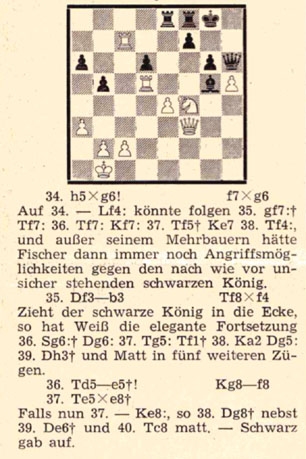
The relevant note is at move 35: ‘Zieht der schwarze König in die Ecke, so hat Weiß die elegante Fortsetzung 36 Sg6:+ Dg6: 37 Tg5: Tf1+ 38 Ka2 Dg5: 39 Dh3+ und Matt in fünf weiteren Zügen.’ (English translation: ‘If the black king goes into the corner White has the elegant continuation 36 Nxg6+ Qxg6 37 Rxg5 Rf1+ 38 Ka2 Qxg5 39 Qh3+ and mate in five more moves.’)
As the Fischer v Bolbochán game was played in round 21 of the
Stockholm tournament, i.e. on 3 March 1962, we now learn that the
illegal line was seen the following month already. Will this topic
produce any further surprises?
C.N. 4172 (15 February 2006):
In a feature in CHESS, July 1976, pages 322-323 Irving Chernev discussed the Fischer v Bolbochán game and pointed out the non-existent mate:

The note nonetheless remained the same in the 1994 (algebraic) edition of Evans’ Modern Chess Brilliancies.
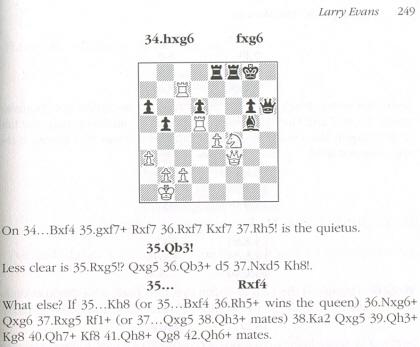
Addition (extract from C.N. 4218, dated 8 March 2006):
Naturally enough for someone who is ‘arguably the most highly acclaimed chess writer in the world’, in most of Nunn’s books he stands as the sole author. Where he has worked on somebody else’s book, for the production of an algebraic edition (an exercise involving more pitfalls than might be thought), the outcome has not always been happy. The most regrettable case, the My 60 Memorable Games débâcle in the mid-1990s, was by no means his sole responsibility but it entailed uncharacteristic lapses of judgment, both pre- and post-publication. When describing in Grandmaster Chess Move by Move a string of inglorious Batsford doings, Nunn had a golden opportunity (or, indeed, a golden obligation) to include a belated word of contrition about the Fischer episode, and it is inexpressibly disappointing that, a decade on, he still felt unable to do so, passing over the aberration in silence.
Addition (19 February 2007):
The following appeared on page 233 of Great Games by Chess Prodigies by Fred Reinfeld (New York, 1967 and 1972), with a white rook at c5 instead of d5:
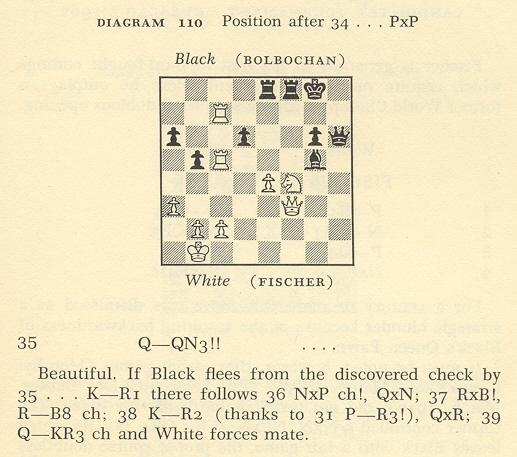
Addition (4 March 2007):
Leonard Barden annotated the game on page 78 of the April 1962 Chess Life. His note at move 35 gave a line in which Qh3+ did indeed force mate, since that was at move 38, not 39 (the Zwischenzug 37...Rf1+ being omitted).

Addition (30 March 2007):
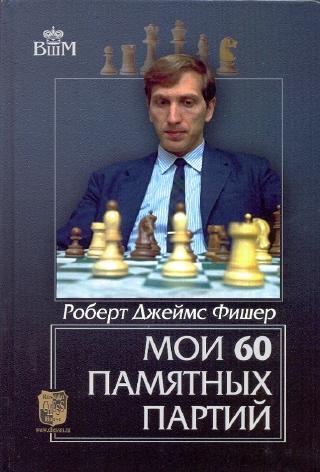
The Russian translation of Fischer’s My 60 Memorable Games has been reissued (Moscow, 2006), and in Fischer v Bolbochán the non-existent mate remains (page 128):
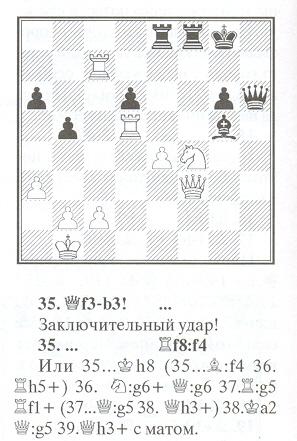
With the permission of Mr David DeLucia we reproduce the following from page 265 of his new volume (see C.N. 5323):
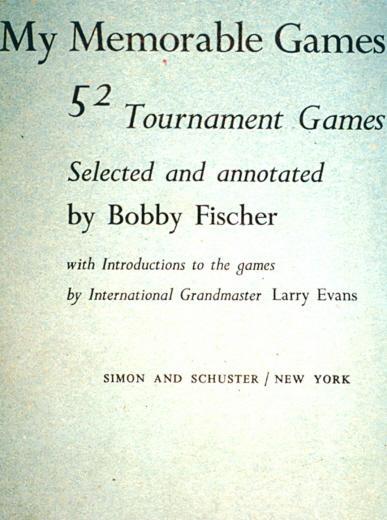
Dated 1967, this comes from ‘a rare “review copy” of a book that was never published which was in Bobby Fischer’s personal library’. Mr DeLucia also remarks that two years later My 60 Memorable Games was published, ‘the first 52 being the same as the review copy’.
(5352)
Addition (20 November 2008):
In October 2008, nine months after Fischer’s death, Batsford published a new algebraic edition of My 60 Memorable Games, and commented on the back cover:
‘In contrast with the previous edition of this book, no alterations have been made to the text other than the conversion of moves into algebraic notation, making this an updated yet accurate reflection of the original book.’
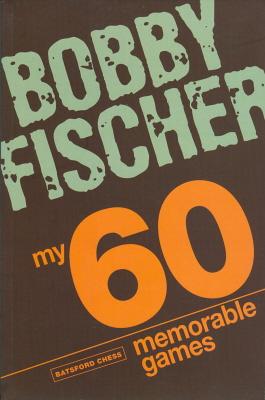
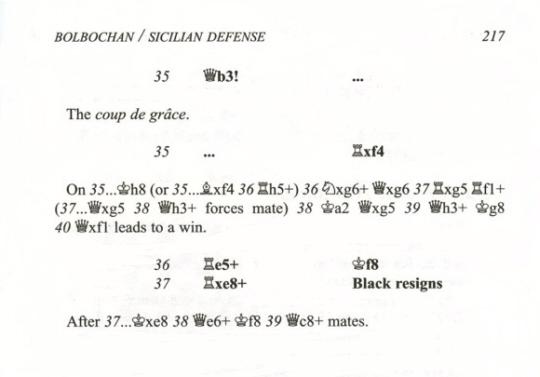
Dennis Monokroussos (South Bend, IN, USA) disputes the statement on the back cover of the 2008 edition of Fischer’s My 60 Memorable Games that ‘in contrast with the previous edition of this book, no alterations have been made to the text other than the conversion of moves into algebraic notation, making this an updated yet accurate reflection of the original book’, given that the faulty score of a 1959 Fischer v Tal game has been corrected. Our correspondent asks whether we are aware of any other changes in the new edition.
The Fischer v Tal encounter (Game 17) gave rise to the following position after 50 Kb4:

The game concluded 50...Kc7 51 Rb5 Ba1 52 a4 b2, and White resigned. Source: Page 275 of Kandidatenturnier für Schachweltmeisterschaft by S. Gligorić and V. Ragozin (Belgrade, 1960), as well as other publications of the time.
However, in the first edition of Fischer’s book (page 122) the final moves were given as ‘50...B-R8 51 P-QR4 P-N7! White resigns’. This would have allowed Fischer to win with 51 Rc8+. The fact that Tal had played 50...Kc7, and not 50...Ba1, was pointed out by B.L. Patteson on page 146 of the March 1970 Chess Life & Review, in the column ‘Larry Evans On Chess’. Evans commented:
‘Fischer assures us that he caught this error before the book went to press, but that his correction must have fallen off the page by the time it reached the printer. Anyone familiar with the monumental effort that goes into any book knows that perfection is impossible.’
The matter was also raised by D.M. Horne on page 19 of the January 1972 BCM, and the magazine’s editor confirmed that the score in Fischer’s book was faulty.
The inaccurate sequence ‘50 K-N4 B-R8 51 P-QR4 P-N7! White resigns’ was amended, in the 1972/73 Faber and Faber edition, to ‘50 K-N4 K-N4 51 R-N5 B-R8 52 P-QR4 P-N7 White resigns’. This would-be correction remained in the British publisher’s 1988 edition, but Black’s 50th move should read ...K-B2, and not the impossible ...K-N4.
The Batsford editions of 1995 and 2008 both give the conclusion of the game accurately.
As regards Mr Monokroussos’ question about other changes to the 2008 edition, we note that some further textual corrections have indeed been made. In our article on pages 45-48 of the January 1997 CHESS about the 1995 edition of Fischer’s book, we included a section entitled ‘Mistakes not corrected’:
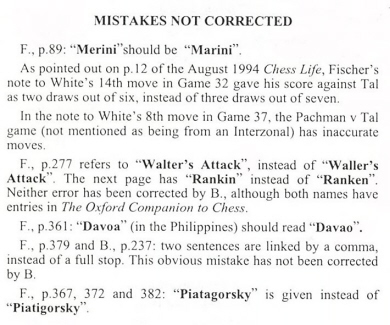
With the exception of the point regarding Game 32, the 2008 edition has corrected all these matters, silently. (See also C.N. 4867.)
Batsford was certainly right, in 2008, to wish to rectify clear-cut factual errors, but we feel that a) the back-cover claim that the text is unaltered was ill-advised, and b) any changes should have been mentioned explicitly and openly, either in footnotes or in an errata section.
(5883)
In his Introduction to the ChessBase CD World Champion Fischer Robert Hübner writes as follows regarding My Sixty Memorable Games:
‘Most critics deem Fischer’s comments to be entirely devoid of errors, and each and every one of his observations is accepted as gospel truth. I was plagued by the desire to find out whether this reputation is indeed justified. Unfortunately, however, there is only one way of finding out: get down to the hard work of going through all of Fischer’s notes; and so I went through his oeuvre of annotations to find passages that seemed dubious to me.’
Hübner also analyzed games not included in Fischer’s book, and one of them relates to a position which was discussed in C.N.s 2317 and 2327 by Amatzia Avni and Elie Agur (see pages 30-31 of A Chess Omnibus). The following position arose after Black’s 14th move in Fischer v Czerniak, Netanya, 1968:

Page 173 Agur’s book Bobby Fischer: A Study of His Approach to Chess (London, 1992) had given Fischer’s next move, 15 Nc1, two exclamation marks, with the following comment:
‘It isn’t very easy to define genius at chess. This though is a very good example of it. The plan Fischer contrives here is a combination of positional elements which viewed one by one are each a déjà vu idea. Put together, they are an exceptional “never seen before” conception.’
Hübner analyzes the position, mildly criticizing 15 Nc1 (instead of which he recommends 15 h3), 15…Bxf3 (15…e5 is found to lead to approximate equality) and 17 Qb3 (17 dxe5 Nxe5 18 Nb3 is preferred). Above all, Hübner singles out 17…exd4 as a bad mistake (instead of which, he says, 17…Nf6 led to a roughly equal position).
The CD is in both German and English. Not all the games in Fischer’s book are discussed by Hübner, but in those which are featured he picks out key positions for detailed scrutiny, sometimes agreeing with Fischer’s conclusions and sometimes differing.
(2948)
See also the detailed discussion of the Fischer v Czerniak game on pages 180-194 of Materialien zu Fischers Partien by Robert Hübner (Ludwigshafen, 2004).
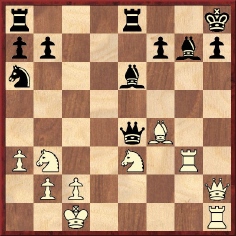
White to move and win
A.R.B. Thomas (1904-85) gained a dose of immortality through being quoted by Bobby Fischer in My 60 Memorable Games (New York, 1969). This occurred in his notes to the second match-game between Fischer and Reshevsky in 1961 (game 26), of which the conclusion is reproduced below:
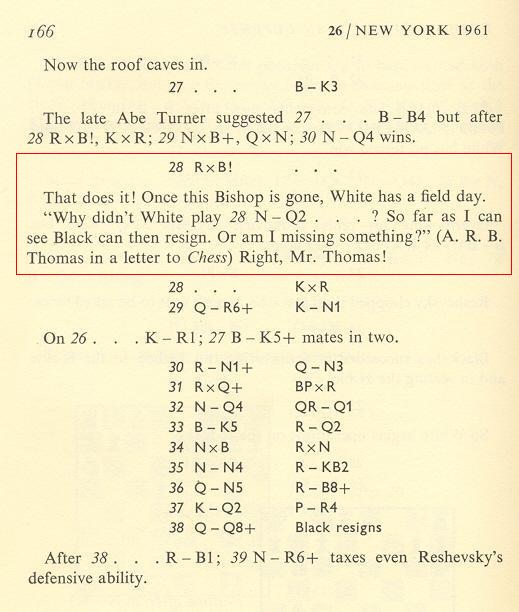
The logic of the note is unclear. Since 28 Rxg7 receives an exclamation mark, it might even be inferred that Fischer’s comment ‘Right, Mr Thomas!’ was sarcasm. Puzzlement over this matter was, understandably, expressed by a reader on page 66 of the February 1989 Chess Life. Page 267 of ‘Garry Kasparov on Fischer My Great Predecessors Part IV with the participation of Dmitry Plisetsky’ (London, 2004) gave ‘28 Rxg7!? (28 Nd2!)’.
Thomas’ letter in CHESS was published on page 249 of the Easter 1966 issue:
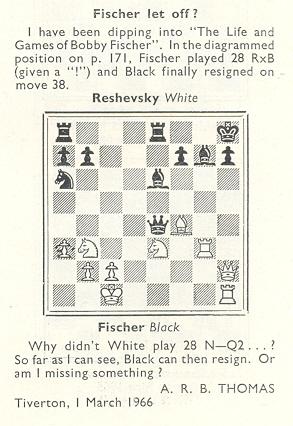
The book to which Thomas was referring was the Fischer biography by Frank Brady (Profile of a Prodigy), published the previous year. There is, though, a curiosity, as Thomas was not the first person to suggest 28 Nd2. Indeed, he was not even the first in CHESS. Several years earlier, on page 409 of the October 1961 issue, the following appeared:
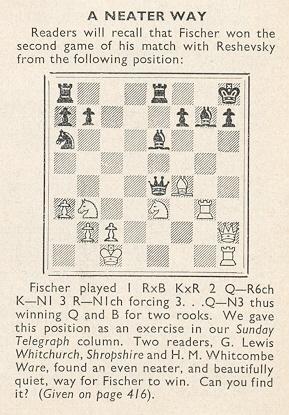
The solution on page 416:



From Fischer’s My 60 Memorable Games (1969)
(4854)
David DeLucia (Darien, CT, USA) informs us that on page 163 of the 1967 review copy of Fischer’s Memorable Games book (containing only 52 games – see C.N. 5352) the note at move 28 in his game against Reshevsky, New York, 1961 merely read:
‘That does it! Once this Bishop is gone, White has a field day.’
Thus the reference to A.R.B. Thomas was added subsequently, at which time the concomitant need to remove the exclamation mark appended to 28 RxB may have been overlooked. Fischer’s ‘Right, Mr Thomas!’ observation would therefore be not sarcasm but acceptance of correction.
(5388)
In C.N. 4867 Jonathan Hinton (East Horsley, England) referred to Bertok v Fischer, Stockholm, 1962, which is game 34 in Fischer’s My 60 Memorable Games. It began 1 d4 d5 2 c4 e6 3 Nc3 Be7 4 Nf3 Nf6 5 Bg5 and continued:
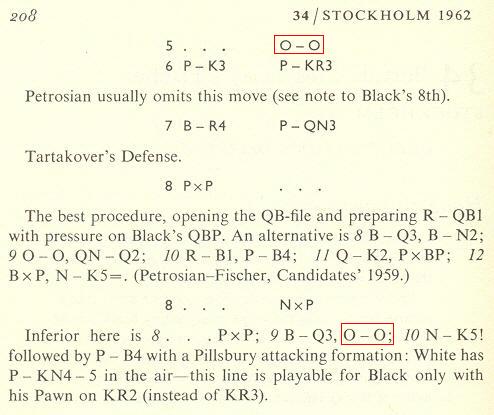
Our correspondent commented, firstly, that the note at Black’s eighth move is faulty: 9...O-O is not possible, since Black has already castled. Secondly, he pointed out that his 1988 Faber and Faber edition of the book (a paperback with a black cover) attempted to correct the mistake but made matters worse: instead of ...O-O being changed to ...B-N2 in the note to Black’s eight move, that alteration was introduced, impossibly, in the score of the game, at move five:
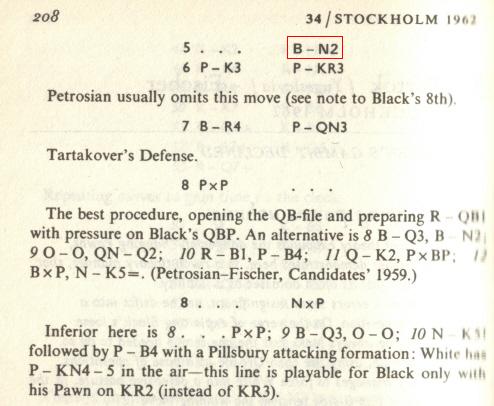
We added a complication: our own copy of the 1988 ‘black edition’ is slightly different from Mr Hinton’s (on the back cover they are priced at £4.95 and £7.99 respectively). Our copy still has ...O-O in both places.
It seems that only the 1995 Batsford edition (page 130) has this matter correct: 5...O-O in the game-score and 9...Bb7 in the note at move eight. How did the confusion arise?
Russ Glover (Alpena, MI, USA) asks whether an errata list has ever been compiled for the first edition of Fischer’s My 60 Memorable Games.
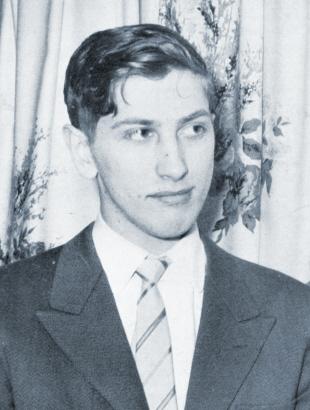
Bobby Fischer
(5886)
Addition on 4 May 2009: We have acquired a new reprint of the 1969 descriptive edition, brought out by Ishi Press International. A strange paragraph on the back-cover is reproduced here:

C.N. 6189 reported that Bobby Fischer Uncensored by David and Alessandra DeLucia (Darien, 2009) contains much documentation regarding the 1995 Batsford edition, including (on pages 204-205) reproductions of Graham Burgess’s letter to Fischer dated 7 September 1994 announcing that Batsford planned a new edition (‘no new errors will be brought into the book’) and the reply from Fischer’s lawyer John Hazard (14 November 1994) stating that ‘Batsford Ltd. is mistaken in its assumption that it has the authority to publish a new edition of My Sixty Memorable Games’. The affair is also mentioned in detail in the extracts presented (on pages 248-261) from another item in Mr DeLucia’s collection, dated 18 November 1997: ‘a 100-page working typescript by Fischer entitled “What Can You Expect from Baby Mutilators”’.
Addition (7 November 2009):
Below are the complete texts of C.N.s 2268 and 2298, which appeared respectively in the 3/1999 and 5/1999 issues of New in Chess:
In a radio interview with DZSR (Metro Manila) on 10 March 1999 Fischer called us a ‘bastard’. (Thank you very much.) His grievance is our purported statement that the 1995 Batsford edition of My 60 Memorable Games contained ‘some 640’ alterations, whereas in reality, according to Fischer, there were ‘thousands upon thousands and thousands and thousands of changes’ to his work.
The affair may be summarized briefly here. After Fischer made his original denunciation of the Batsford version the magazine CHESS engaged us to compare it with the Faber and Faber edition. We scrutinized the two books line-by-line and found that Batsford had made over 570 textual changes. An extensive sample was listed on pages 45-48 of the January 1997 CHESS, under the following headings: omission of entire notes of Fischer’s; omission of certain words of Fischer’s; additions to Fischer’s words; other changes to Fischer’s phraseology; inconsistency; mistakes not corrected; mistakes added by Batsford. A number of amendments were serious faults; many were capricious (i.e. unnecessary) modifications of Fischer’s own prose. Our conclusion was that the American’s work had been butchered and that Batsford’s statement that ‘there was no addition or subtraction of intellectual material’ could be regarded as an outright lie.
Fischer’s allegation of thousands of changes is wrong. On the other hand, 570 is itself a colossal number, and even if there had been far fewer Batsford’s conduct would still be atrocious. Its defilement of My 60 Memorable Games is, we believe, without parallel in chess history.
(2268)
Fischer has intensified his criticism of us regarding My 60 Memorable Games; in a radio interview on 27 June 1999 he promoted us to ‘phoney bastard’, and much else besides. He still maintains that we grossly underestimated the number of textual changes in the Batsford edition of My 60 Memorable Games, and from this he deduces that we are part of the ‘controlled opposition’ and are ‘working for the Jews’.
Ignoring the personal, political and racial attacks, we give below Fischer’s substantive points, adding our own brief replies in brackets:
(a) Batsford made significant alterations to his book which our January 1997 article in CHESS did not mention. (Perfectly true, but our article specifically stated that it was providing only a selection of examples.)
(b) The Batsford edition unjustifiably changed ‘Olympiad’ to ‘OL’ and ‘Championship’ to ‘Ch’, and there were, Fischer estimates, approximately 78 instances of the latter alteration. How, then, could we have reached only about 570 changes of all kinds for the entire book? (We noted the ‘OL’ and ‘Ch’ points, but it would hardly have been fair or appropriate to include each such instance in the total.)
(c) There were ‘hundreds’ of changes in one note alone, i.e. to White’s 7th move in Game 58. (This note was indeed extensively recast by Batsford, as we observed during our verification work, but ‘hundreds’ of changes is, again, a mighty exaggeration.)
In his radio broadcast the American even criticized our remark in Inside Chess that ‘Batsford treated Fischer scandalously’, on the grounds that it was phrased far too weakly. He also took issue with our general observation in the American Chess Journal in 1993 that he ‘makes statements which, without warning, switch from perspicacity to absurdity and back again’.
We plan to offer a review of the entire My 60 Memorable Games affair in our August article for the Chess Café on the Internet. It will include scrutiny of Batsford’s (characteristically grotesque) reaction to Fischer’s complaints and an examination of Larry Evans’ (characteristically inept) involvement in the matter.
(2298)
The article mentioned in the final paragraph above duly appeared as ‘Fischer’s Fury’.
Bill Kiplinger (Hacienda Heights, CA, USA) reports that he has a hardback copy of Fischer’s My 60 Memorable Games which, despite being dated 1969 and indicating ‘First printing’ on the imprint page, has, on its dust-jacket, a table of Fischer’s playing record which extends to the 1971 match against Petrosian.
Our collection also contains that edition. Was ‘First printing’ an error, or did Simon and Schuster, in the early 1970s, place a new dust-jacket on its unsold stock of the original 1969 volume?
(6213)
From page 287 of Bobby Fischer Uncensored by David and Alessandra DeLucia (Darien, 2009) we reproduce a note by Fischer dated 8 July 1999:
‘The Jews claim that I’m mentally ill but they’re the ones who are mentally ill. What terrible hatred inside of them compelled them to forge an illegal mating variation in the Batsford edition of “My 60 Memorable Games” in my game with Bolbochan. And in the 1988 Faber and Faber edition of “My 60 Memorable Games” what compelled them to forge “winning the Bishops pawn” rather than what I really wrote “winning the two Bishops”. They’re the ones who are mentally ill!!!’
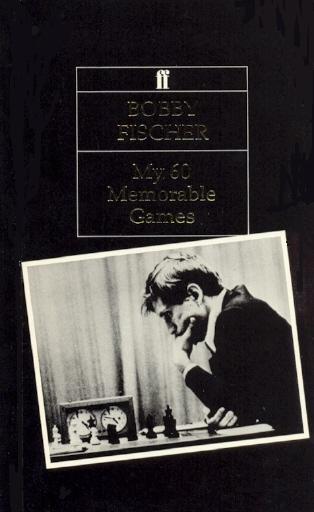
The Faber and Faber edition ‘Reissued 1988’
Page 288 of Bobby Fischer Uncensored has a note by Fischer dated 6 August 1999:
‘Notice I wrote “winning the two Bishops” not “winning two Bishops”. “Winning the two Bishops” is chess lingo for gaining the theoretical advantage of having two Bishops versus your opponent’s Bishop and a Knight. Faber and Faber understood this perfectly well.’
C.N. 4867 referred to textual discrepancies relating to the 1988 Faber and Faber edition. Who in that company made changes to Fischer’s text, and why?
(6214)
C.N. 6214 quoted complaints by Fischer, dated 8 July and 6 August 1999, that the 1988 Faber and Faber edition of My 60 Memorable Games changed an annotation from ‘winning the two Bishops’ to ‘winning the Bishop’s pawn’.
He gave no further particulars, but we see that the comment in question concerns move eight in Gudmundsson v Fischer, Reykjavik, 1960 (Game 19, page 129).
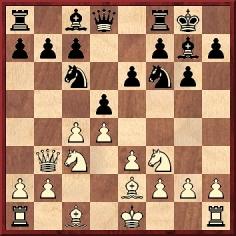
Black has just played 7...Nc6, and the first sentence of Fischer’s original note to 8 Qc2 reads:
‘Probably best (Black threatened ... N-QR4 winning the two Bishops).’
The Faber and Faber edition mentioned by Fischer falsified the note by putting:
‘Probably best (Black threatened ... N-QR4 winning the Bishop’s pawn).’
C.N. 4867 reported that there exist two editions of the black-cover Faber and Faber volume, and for simplicity’s sake they are referred to here as ‘Black 1’ and ‘Black 2’. Their front covers are identical, but the respective back covers are:
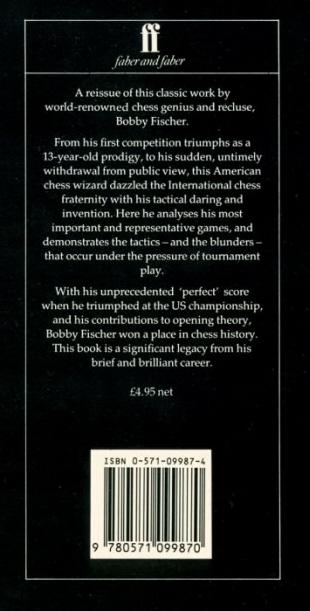
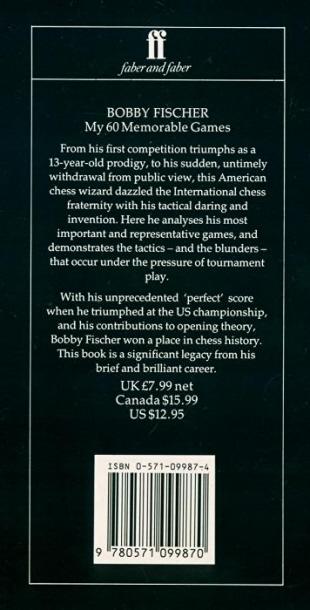
‘Black 2’ introduced the textual change in the Gudmundsson v Fischer game.
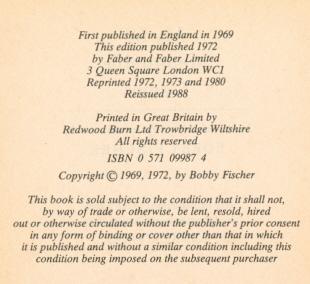
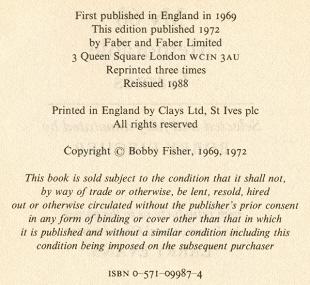
Above are the respective imprint pages of ‘Black 1’ and ‘Black 2’. Whether both editions were indeed published in 1988 is unclear, given that the UK price of ‘Black 2’ was 60% higher. It will be seen, in particular, that there was a change of printer, as well as, on the imprint page of ‘Black 2’, a misspelling of Fischer’s name.
In the Gudmundsson v Fischer game, the 1995 Batsford edition, for its part, made one of its characteristic little alterations: ‘Probably best (Black threatened ...Na5 gaining the two bishops).’
(6226)
Luc Winants (Boirs, Belgium) points out another black-covered edition of Fischer’s My 60 Memorable Games:

Although the prices place this edition second in the series of the three now known, the imprint page, with its references to 1989 and 1990, gives the impression that it came third:
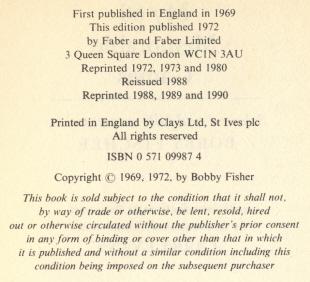
With regard to the Bertok and Gudmundsson games, this edition has the same textual changes as ‘Black 2’.
(6230)
It seems, incidentally, that despite all the textual tampering no edition of Fischer’s My 60 Memorable Games has yet used the correct spelling McCutcheon (in connection with Game 52).
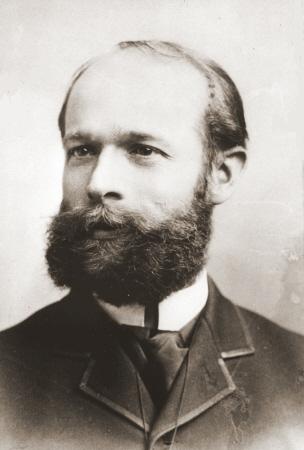
John Lindsay McCutcheon (1857-1905)
(6217)
Still on the subject of Fischer’s My 60 Memorable Games, in a note at move 12 in Game 2 Tarrasch was quoted: ‘Before the endgame the gods have placed the middle game.’ It is indeed one of the German master’s best-known phrases, and we note in his writings two occurrences of the original German (‘Aber vor das Endspiel haben die Götter das Mittelspiel gesetzt’):
1) Note to 30 Qxa7 in Wolf v Tarrasch, Monte Carlo, 1903, in the Berliner Lokalanzeiger, reproduced on pages 111-112 of the April-May 1903 Wiener Schachzeitung;
2) Note to 12...Bf6 in Maróczy v Tarrasch, Ostend, 1905 in the Berliner Lokalanzeiger, reproduced on pages 275-276 of the September-October 1905 Wiener Schachzeitung.
Both games were included in Tarrasch’s book Die moderne Schachpartie (various editions), and the ‘gods’ remark thus appears twice. Below are the passages on pages 96 and 356 of the fourth edition (Leipzig, 1924):
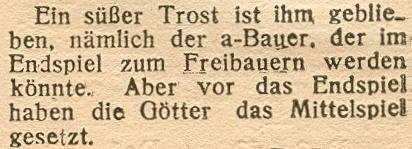

(6218)
We continue to add items of relevance to Fischer v Bolbochán, Stockholm, 1962. From page 209 of The Golden Dozen by Irving Chernev (Oxford, 1976):

(6673)
From page 32 of My 60 Memorable Games by Bobby Fischer (New York, 1969):

Horacio Paletta (Buenos Aires) remarks that Herman Pilnik had gone to live in Argentina many years before the 1939 Olympiad, and that in any case he was not a participant in that event.
We note that Pilnik was named as one of the ‘elementos nuevos’ on page 190 of the July-August 1933 issue of El Ajedrez Americano, which gave two of his games (against Valentín Fernández Coria and Roberto Grau) from the Buenos Aires, 1933 tournament.
A photograph from page 308 of the October 1938 issue of the Argentinian magazine, with Pilnik standing second from the right:
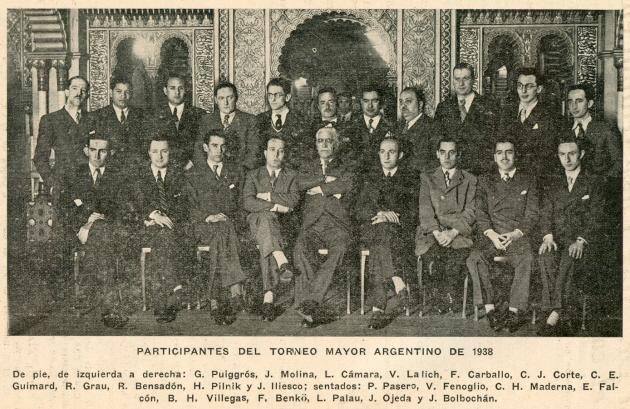
(6926)
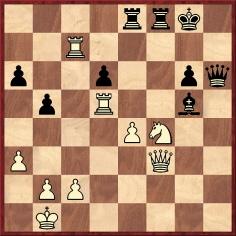
This position was given on page 39 of the August 1990 Chess Life, in Larry Evans’ ‘What’s the best move?’ feature. The solution (page 58):

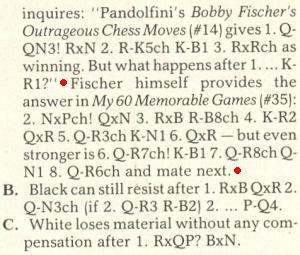
(6991)
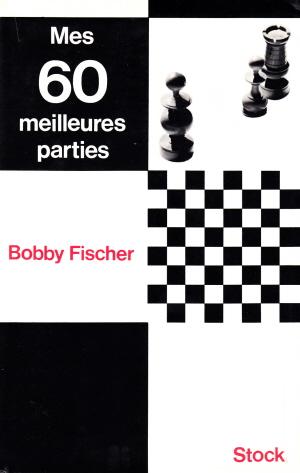
C.N. 867 (see page 149 of Chess Explorations) noted the flavourless and inaccurate French translation (by Parviz M. Abolgassemi) in Fischer’s Mes 60 meilleures parties (Paris, 1972), although the book claimed to have been ‘entièrement revu et corrigé’ by Chantal Chaudé de Silans. The examples given were:
C.N. 867 was published in 1984. Just over a decade later Editions Editéchecs, Paris reissued Fischer’s book, without any attempt to correct the translation.
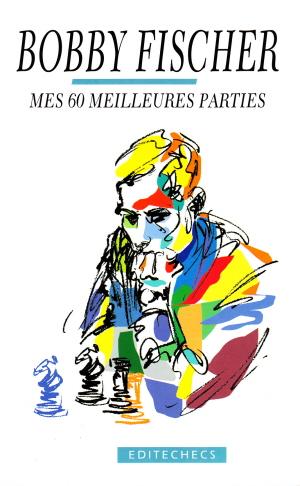
(7655)
Louis Morin (Montreal, Canada) notes how the above passages had appeared in the first edition of the book (also published by Stock, Paris in 1972):
A) ‘Une fois de plus à court de temps. Comme si Sherwin se refusait à comprendre.’
B) ‘Alékhine a dit, au début de sa carrière ...’
C) ‘Une dernière chance.’
D) ‘J’étais informé que Gligoric pensait que je m’étais trompé, ...’
E) ‘Gardant le suspense.’ (No change to the translation.)
Mr Morin also mentions a case where the translation in the ‘corrected edition’ was made worse. A sentence in the introduction to Game 44 refers to the Evans Gambit and reads:
‘This ploy has all but disappeared from the arena.’
- First edition: ‘Ce gambit, quoique valable, a disparu.’
- ‘Corrected’ edition: ‘Ce gambit est loin d’avoir disparu.’
Below is the front cover of a later reprint of the ‘corrected’ text (Editions Garnier Frères, 1982):
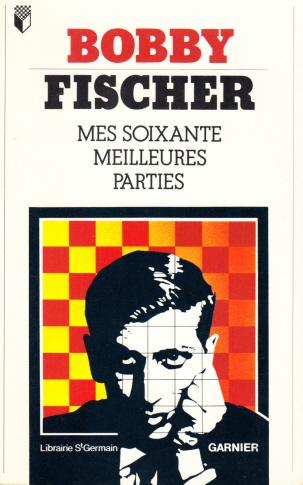
We have been looking further at the two editions of Parviz M. Abolgassemi’s French translation of My 60 Memorable Games (i.e. with and without the revisions of Chantal Chaudé de Silans).
Although Mr Abolgassemi could translate statements such as ‘White wins a pawn’ without incident, Fischer’s more colourful phrases were beyond him. One example, from game 45 (after 27 Be5):
‘Bisguier slumped and his chest collapsed ...’
‘Besguier se penche tout à coup ...’
The revised edition made more of an effort:
‘Bisguier s’affaissa et courba les épaules ...’
Various names are misspelled in both French editions (e.g. Bryn, Spielman, Kmotch and Anderson), and a proper French translation of Fischer’s book is more than 40 years overdue.
(8088)
On page 7 of the March 2008 CHESS Larry Evans referred to:
‘... the botched algebraic edition printed by Batsford in 1995, edited by GM John Nunn.’
Addition on 10 November 2012:
On 5 November 2012 Pedro Federico Hegoburu (Buenos Aires) pointed out that Fischer’s criticism of the 1995 Batsford book which we quoted at the start of the Fischer’s Fury article was addressed to him and not to Juan Sebastián Morgado, although the conversations took place in the latter’s bookshop.
The original account of Fischer’s complaints was published in the April-August 1996 issue of Ajedrez de estilo. Mr Morgado has kindly forwarded us the magazine, and the relevant passages, from pages 20 and 21, are reproduced here:
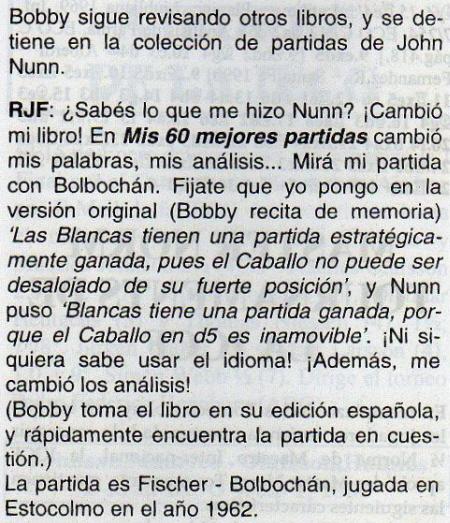
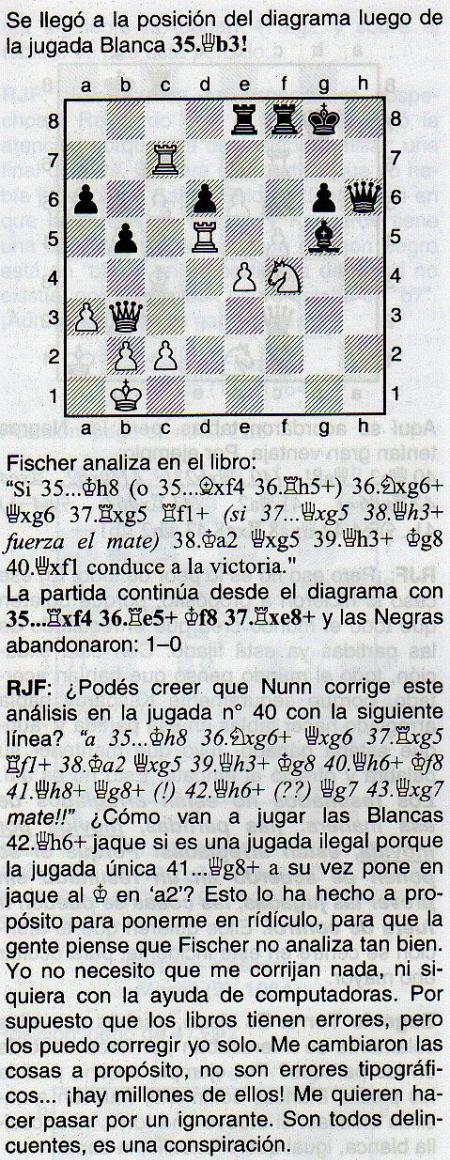
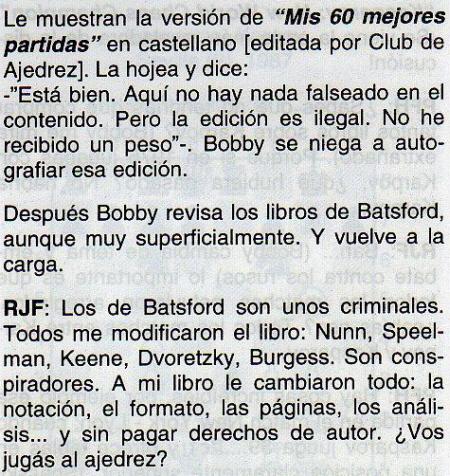
An English translation by Jonathan Berry of Pedro Federico
Hegoburu’s article (as it had subsequently appeared in Jaque)
was published on pages 4-7 of Inside Chess, 23 December
1996. See too pages 164-166 of The Unknown Bobby Fischer
by John Donaldson and Eric Tangborn (Seattle, 1999).
Other remarks by Fischer about the Batsford episode were quoted by Juan S. Morgado on pages 5-6 of the above-mentioned edition of Ajedrez de estilo, following the press conference given by Fischer in Buenos Aires on 16 June 1996:
‘Antes de la conferencia de prensa propiamente dicha, Bobby arremete contra quienes llama “editores ilegales” de sus obras. Muestra un ejemplar en inglés de Mis 60 memorables partidas, editado por Batsford, y explica dónde han cambiado palabras y variantes ...
“Aquí cambiaron la palabra ‘defenderse’ por ‘replegarse’. Si uso la palabra ‘defenderse’ en la página anterior, no voy a repetirla porque eso es no saber usar el lenguaje. Todo el mundo lo sabe. Pero me cambian las palabras porque quieren hacerme aparecer como un tonto. Ni a Hitler, que yo sepa, le cambiaron las palabras de Mein Kampf.”
Muy enojado, continúa mostrando el libro, y agrega:
“En el libro original, publicado por una editorial norteamericana en 1969, la tapa era color naranja y la contratapa blanca. ¿Por qué en la reedición de la editorial inglesa utilizan el celeste y el negro? Obvio. La intención es hacerme aparecer como un personaje oscuro y tenebroso. Nadie me pagó un solo dolar por estas ediciones.”
Días más tarde, Batsford contestaba a través de la internet, diciendo que había comprado los derechos a Faber y Faber (?) (Bobby sólo reconoce a Simon y Schuster) y que había efectuado algunos cambios para adaptarlos al público de habla inglesa.’
Have any readers seen an edition of Fischer’s My 60 Memorable Games which has a diagram after every move?
From page 134 of Great Chess Books of the Twentieth Century in English by Alex Dunne (Jefferson, 2005):
‘Fischer’s My 60 Memorable Games was published by Cesar Pineda; in it, every move of every game in My 60 Memorable Games was diagrammed.’
(8019)
Among the many chess oddities on the English-language Wikipedia site are a disproportionately long, though interesting, entry on Grace Alekhine and a Fischer-related page whose three-line section on My 61 Memorable Games ends:
‘Larry Evans originally thought it was possible that it was a pirated version of a genuine Fischer manuscript, but in April 2008 concluded it was a hoax.’
Mr Evans asserted that the 1995 Batsford edition of My 60 Memorable Games was better than the original, and there can hardly be value in chronicling what such an individual may have originally thought was possible, or what he later concluded, about My 61 Memorable Games, a book which he never even saw.
(8130)
From page 65 of the February 1969 Chess Life:
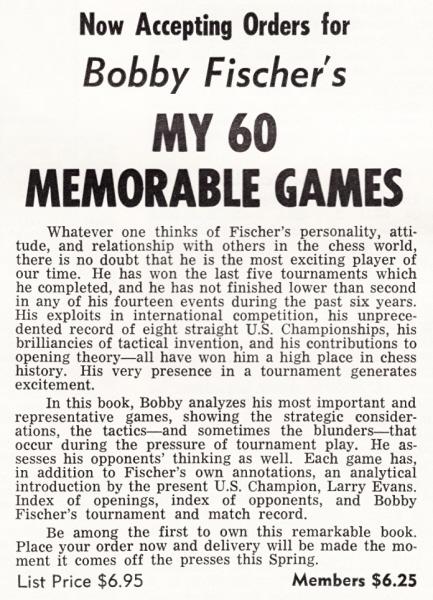
The availability of Fischer’s book in the United States Chess Federation’s inventory was announced on page 150 of the April 1969 Chess Life, and the magazine’s Editor, Burt Hochberg, wrote a detailed review on pages 235-236 of the June 1969 issue.
But what about the United States’ other major chess magazine of the time, Chess Review (Editor: I.A. Horowitz)? We have searched in vain throughout the 1969 volume of Chess Review for the slightest mention of My 60 Memorable Games. Why was it ignored?
(8226)
See too C.N. 10243, which discussed references to the book in US chess magazines’ catalogues of the time.
Concerning game 26 in Fischer’s My 60 Memorable Games, Stuart Rachels (Tuscaloosa, AL, USA) notes that after 1 e4 c5 2 Nf3 Nc6 3 d4 cxd4 4 Nxd4 g6 5 Nc3 Bg7 6 Be3 Nf6 7 Be2 Fischer wrote on pages 161-162:
‘In the 4th and 6th games of the match [against Reshevsky in 1961] I continued with 7 B-QB4 O-O 8 B-N3 N-KN5 [...] 9 QxN NxN and White got a clear advantage both with 10 Q-R4 and 10 Q-Q1, respectively.’
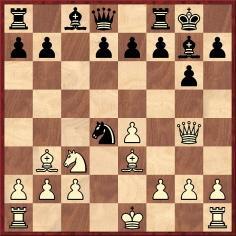
Position after 9...Nxd4
Mr Rachels points out that, given the play in the fourth and sixth match-games, this note should read ‘with 10 Q-Q1 and 10 Q-R4, respectively’. Moreover, he considers that after the latter move White has only a tiny advantage.
My 61 Memorable Games (pages 295-296) included additional material, of unestablished provenance, as shown in our feature article.
(8306)
From the back cover of a reprint (issued by Ishi Press International in 2009) of the original descriptive-notation edition of My 60 Memorable Games by Bobby Fischer:
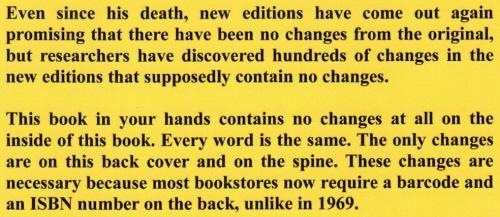
‘This book in your hands contains no changes at all on the inside of this book. Every word is the same.’
Not exactly, as a comparison with the original 1969 edition immediately shows:
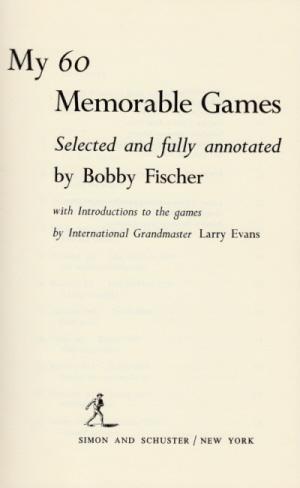
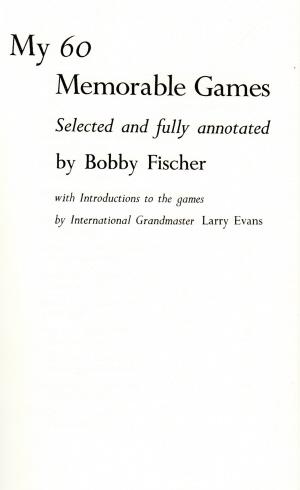
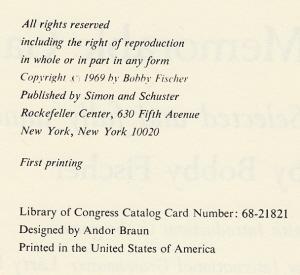
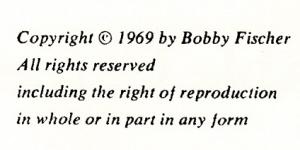
(8483)
True Combat Chess by Timothy Taylor (London, 2009) has this entry in the bibliography on page 5:
(8834)
From page 100 of Chess Tactics by Alexander Kotov (London, 1983):
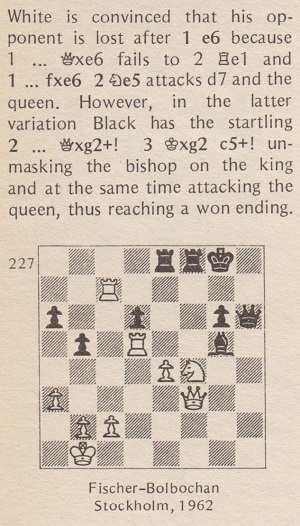
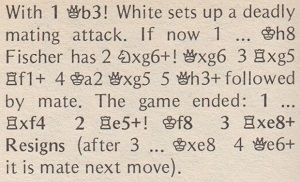
A photograph of Fischer in Buenos Aires, 1996 holding up the descriptive and algebraic editions of My 60 Memorable Games is on page 267 of Bobby Fischer, Leyenda by C. Ilardo, F. Braga and C. Minzer (Santa Eulalia de Morcín, circa 2009).
In C.N. 6926 (see above) a correspondent pointed out a mistake about Pilnik in the introduction to game four in My 60 Memorable Games. Nobody involved in the book ever seemed concerned that the game introductions have many errors, as in game 56:
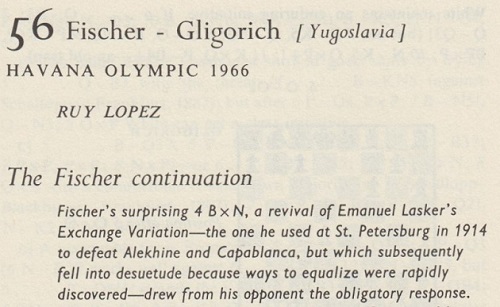
At St Petersburg, 1914 Lasker’s victory over Alekhine in the Exchange Variation of the Ruy López was with the black pieces.
(9059)
The omission from the book of Fischer’s famous victory over Donald Byrne, New York, 1956 was discussed in C.N. 10238.
From pages 197-198 of Modern Chess Brilliancies by Larry Evans (New York, 1970/71):
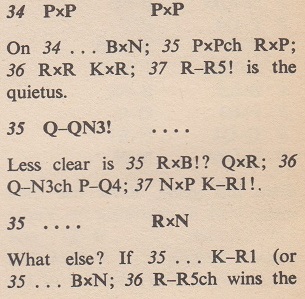
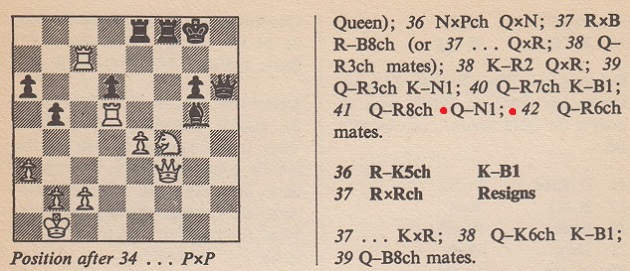
On pages 322-323 of CHESS, July 1976 Irving Chernev wrote:
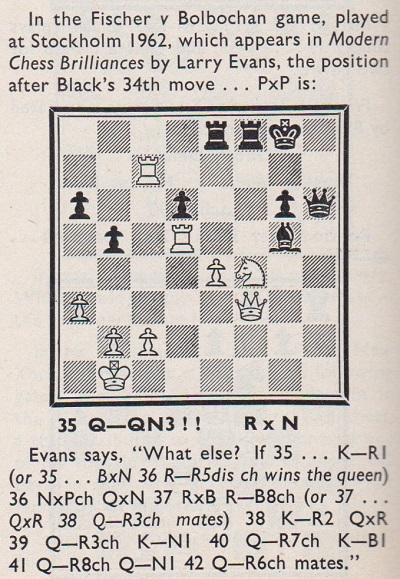

Evans made no correction on page 249 of the algebraic edition of Modern Chess Brilliancies (San Francisco, 1994):
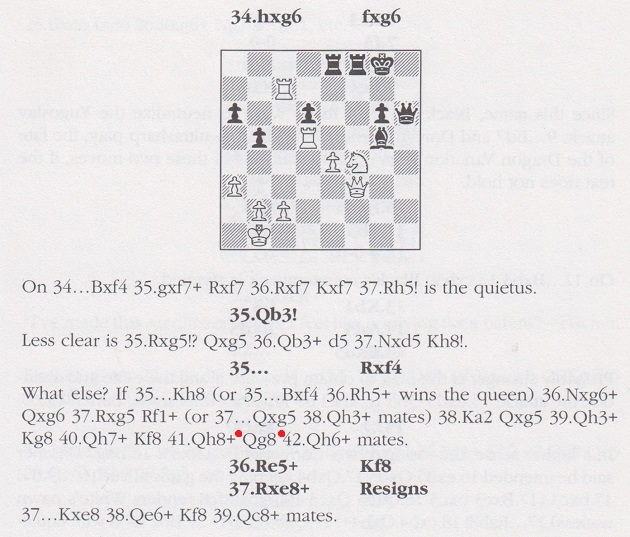
Tony Bronzin (Newark, DE, USA) wonders how such a mistake could have occurred at all in Modern Chess Brilliancies, given a claim by Evans about Fischer on page 16 of Chess Life, March 2008:
‘That year [1969] he was my house guest in Reno. I was working on the manuscript of Modern Chess Brilliancies and asked him to check it for errors. He wanted $100 and I paid it gladly. He went through the games blindfolded and did a wonderful job.’
(11058)
Sean Robinson (Tacoma, WA, USA) notes that Larry Evans also mentioned Fischer’s verification of Modern Chess Brilliancies on page 1 of its 1994 algebraic edition (‘Fischer ... who reviewed this manuscript in 1969 before it went to press when he was a guest at my home in Reno’). There was no word about the review being performed blindfold. The 1970/71 book did not mention any involvement by Fischer.
The algebraic edition also reproduced, on pages 3-14, Evans’ Introduction to the original book. Although dated August 1969, it referred, on page 11, to ‘the stolid grinders like Smyslov, Petrosian, Karpov and Spassky’. Karpov’s name had naturally been absent from the 1970/71 book.
Comparing Modern Chess Brilliancies with Fischer’s My 60 Memorable Games (New York, 1969), our correspondent remarks that the books have 13 games in common, and he provides these extracts from the introductions:
My 60 Memorable Games (page 18, under the heading ‘Slaying the dragon’): ‘In a laudable attempt to create complications, Larsen deviates from the book on move 15. ... an object lesson in how to mount an assault against the fianchettoed king.’
Modern Chess Brilliancies (page 198): ‘Fischer slays the Dragon Variation after an ill-advised attempt on the part of his opponent to complicate. The result is an object lesson in how to mount an assault against the fianchettoed king.’
My 60 Memorable Games (page 137): ‘ ... Fischer causes the overextended White center to crumble. Letelier, busily engaged on a material hunt, neglects to safeguard his rear ... Fischer rapidly encircles the hapless monarch and, with a startling queen sacrifice, induces abdication.’
Modern Chess Brilliancies (page 73): ‘White overextends his center in his hunt for material and neglects to safeguard his rear. His hapless monarch, unable to castle, is soon forced to abdicate.’
My 60 Memorable Games (page 187): ‘This draw has the charm of perfection. ... The economy and ingenuity displayed by both players produces [sic] a harmonious flow of movement, remarkable in its esthetic appeal.’
Modern Chess Brilliancies (page 74): ‘This draw has the charm of perfection. The timing and ingenuity displayed by both players produce a harmonious flow of movement, remarkable in its aesthetic appeal.’
My 60 Memorable Games (page 212): ‘... Bolbochan, burdened with a bad bishop against a good knight, defends with extreme care but is gradually forced to retreat behind his lines. ... Fischer’s invasion on the weakened squares is a model of accuracy. It culminates in a keen combination which, appropiately [sic], earned a tie for the first brilliancy prize.’
Modern Chess Brilliancies (page 196): ‘Burdened with a bad bishop against a good knight, Black defends with extreme care but is gradually forced to retreat behind his lines. Fischer’s invasion on the weakened squares is a model of accuracy, culminating in a keen combination.’
For our part, we have compared these passages with My 61 Memorable Games, which often made irrational textual changes. One example:
My 60 Memorable Games (page 137): ‘Letelier, busily engaged on a material hunt, neglects to safeguard his rear.’
My 61 Memorable Games (page 252): ‘Letelier continues to hunt for material, but he neglects to secure his rearmost vulnerabilities.’
(11078)
Christopher Holmes (Saint-Maur-des-Fossés, France) raises a number of points regarding Fischer’s My 60 Memorable Games, originally published in 1969 by Simon & Schuster in the United States and by Faber and Faber in the United Kingdom, followed by two Batsford editions (1995 and 2008). Quite apart from the unclear copyright position concerning those English-language editions, our correspondent wonders how a potential translator or publisher of the book in another language could set about clearing the rights, through Fischer’s estate. Is the identity of the appropriate contact person known?
Our above-mentioned feature article described the 1972 French edition by Parviz M. Abolgassemi as ‘flavourless and inaccurate’, but it is hard to imagine how a perfect new edition of Fischer’s book could be produced in any language. Which English-language version should be the basis for any translation? How, if at all, should errata be incorporated? Has anybody ever produced an exhaustive list of corrections (on the basis of what was published in 1969)? What attention, if any, should be given to the multitude of alleged analytical improvements in My 61 Memorable Games?
(11941)
As regards the initial publication of the book in the United States and the United Kingdom, in C.N. 7668 Leonard Barden wrote:
‘I was ... the chess adviser to Faber and Faber, whose director, Charles Monteith, had a celebrated record for spotting and publishing winners – which had included Waiting for Godot and Look Back in Anger. Faber and Faber had a mutual arrangement with Simon & Schuster and was offered the British rights (for a low figure) to Fischer’s My 60 Memorable Games, which Monteith took up on my enthusiastic recommendation.’
See too: Articles about Bobby Fischer.
Latest update: 24 March 2025.
To the Chess Notes main page.
To the Archives for other feature articles.
Copyright: Edward Winter. All rights reserved.